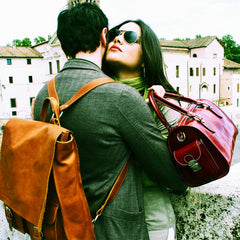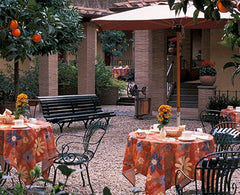Explore the Heart of Rome
Posted by DANA KLITZBERG

 Trastevere means “across the Tiber River,” which is where this bohemian quarter sits, abutting the Gianicolo Hill on the south side of Vatican City. Like many European cities, Rome has its “Left Bank” area, and Trastevere is it: an ancient neighborhood once populated by the city’s Jewish community. It is now an eclectic mix of old-school Romans, artists, expats, and international students. Its inexpensive trattorie and pizzerie are renowned, and its night life is (in)famous. Trastevere’s narrow, cobblestoned vicoli, strung with laundry lines, look like they’ve been ripped from an opera set, and the elderly ladies hanging out of windows and chatting across ancient palazzi seem straight out of central casting. Sure, sometimes the streets are overrun with tourists and drunken college kids on semester abroad. Sometimes Piazza Santa Maria in Trastevere gets crowded with street performers and beggars trailed by packs of dogs. But look beyond the chaos, and you can find not only authentic Italian charm, but pockets of peace and tranquility among the urban hubbub.
Trastevere means “across the Tiber River,” which is where this bohemian quarter sits, abutting the Gianicolo Hill on the south side of Vatican City. Like many European cities, Rome has its “Left Bank” area, and Trastevere is it: an ancient neighborhood once populated by the city’s Jewish community. It is now an eclectic mix of old-school Romans, artists, expats, and international students. Its inexpensive trattorie and pizzerie are renowned, and its night life is (in)famous. Trastevere’s narrow, cobblestoned vicoli, strung with laundry lines, look like they’ve been ripped from an opera set, and the elderly ladies hanging out of windows and chatting across ancient palazzi seem straight out of central casting. Sure, sometimes the streets are overrun with tourists and drunken college kids on semester abroad. Sometimes Piazza Santa Maria in Trastevere gets crowded with street performers and beggars trailed by packs of dogs. But look beyond the chaos, and you can find not only authentic Italian charm, but pockets of peace and tranquility among the urban hubbub.
Accommodations
For the classic Trastevere experience, we suggest renting an apartment in the neighborhood. There are no big chain hotels in this area – part of its charm – but you can find some cute, caratteristico lodgings below…
• Relais Le Clarisse Trastevere (www.leclarissetrastevere.com) – great location and beautiful courtyard garden with lemon and olive trees.

• Hotel Santa Maria (www.hotelsantamariatrastevere.it) – We love the tranquil charm of this Renaissance-era former convent. Simple, clean ground floor rooms encircling an interior courtyard dotted with orange trees, where one can eat breakfast or enjoy an aperitivo before venturing outside for dinner.
Dining
Roman cuisine is about simple, hearty, flavorful food. It’s prepared with local, seasonal ingredients and follows long-held traditions. No cream in the carbonara. Guanciale in the amatriciana. Baby lamb with artichokes and fava beans in the spring; Figs and melon and prosciutto and seafood in the summer. Gnocchi on Thursdays only, for good luck. And many, many more rules that one picks up after experiencing la cucina Romana season after season. The dining rooms may not be Italy’s most elegant (though there are plenty of those places here in the capital, of course), the lighting might be bright and harsh, but dammit, the food is really good.
 Alle Fratte di Trastevere (Via delle Fratte di Trastevere 49/51): Owner Francesco passionately runs our favorite trattoria in town – we often indulge in the simple, delicious fare at this neighborhood favorite. They feature a great variety of Roman and southern Italian dishes, from octopus carpaccio to pasta all’amatriciana, pizza to steaks, and they do it all well. Great food, great service, great atmosphere, all at reasonable prices, keep us coming back time and again.
Alle Fratte di Trastevere (Via delle Fratte di Trastevere 49/51): Owner Francesco passionately runs our favorite trattoria in town – we often indulge in the simple, delicious fare at this neighborhood favorite. They feature a great variety of Roman and southern Italian dishes, from octopus carpaccio to pasta all’amatriciana, pizza to steaks, and they do it all well. Great food, great service, great atmosphere, all at reasonable prices, keep us coming back time and again.
Ripa 12 (Via di San Francesco a Ripa 12): On a major artery leading out from Piazza Santa Maria in Trastevere to the church of San Francesco a Ripa (which contains a gorgeous Bernini statue not to be missed), sits this upscale seafood spot. It’s been a local favorite for years, and a few seasons back it got a facelift and is now lovelier than ever. A coveted sidewalk table under the umbrellas is ideal, particularly in warm weather, and the better to enjoy the delicious antipasto sampler, with super-fresh tartares and carpaccios and the like. The offerings change with the catch of the day, but a great variety of antipasti and a seafood-centric pasta like spaghetti con le vongole (clams) can be a very filling and fulfilling meal. Add a bubbly spumante for even more festive fun!
La Gensola (Piazza della Gensola 15): For a taste of the “exotic,” head to this beautiful tavern-like restaurant for a meal of the foods of Sicily. This largest of Italian islands was once conquered and ruled by Normans, Arabs, Romans, Greeks, and Spaniards, among others. The flavors of these ruling states influenced the local fare, creating a unique cuisine featuring lots of great seafood, spices, herbs and aromatics you won’t find in food on the “mainland.” Try tuna “meatballs” or gratineed scallops with squid ink, then move onto a spicy pasta with calamari, or sardines, bread crumbs, and wild fennel. Perhaps try a fillet of turbot with capers, red onions, and tomatoes as a main course. But leave room for dessert: Sicilians are famous for their sweets, like cannoli and cassata cake.
Bars and Cafes
Bar “Bar” or Il Mojitaro di Vicolo del Cinque (Vicolo del Cinque 5): No one really calls this bar by its official name, because there is a sign that simply reads “BAR” above the entrance. Calling it Bar “Bar” is just what you do. And their steadfast stream of Brazilian baristas explains the great caipirinhas and caipiroskas in this place (and great coffee as well). Friendly owners have even given in to our expat requests for ginger beer, so this is one of the only places where you can find a decent Dark and Stormy in Rome.
Freni e Frizioni (Via del Politeama 4/6): Housed in what was once an auto repair shop (its name means “brakes and clutches”), this repurposed bar from the Torinese team behind successful bars in the north and other Roman hotspots like Société Lutèce, is now a Trastevere staple. They’re known for their ample aperitivo setup, where you can nibble from the buffet table for free with the purchase of a beer, wine, or cocktail. Try the ginger mojito. Hipsters overflow into the piazza by the Ponte Sisto.
Akbar (Piazza in Piscinula 51): Also known as “il nuovo Pucci,” as the owners moved their old bar, Pucci, from a piazza down the street to this address. This location is much better, bigger, cooler. But the crowd makeup is relatively the same: artsy types, bohemian expats, poseurs and party girls. While here one night in January, we were surrounded by paparazzi hiding in bushes and going to extremes to get their photos: turns out Sorrentino, the director of La Grande Bellezza, chose this bar to celebrate his Oscar nomination (yes, he eventually won for Best Foreign Language Film). Like many hot spots in the Eternal City, much of the fun happens outside in the piazza. The bartenders are slow, but they’re cute and theatrical. Molto Romano.
Ma Che Siete Venuti a Fa’ (Via Benedetta 25): It’s miniscule and could be overlooked completely if it weren’t for the fairly consistent stream of noisy carousers overflowing from its entrance. But this bar is a serious stop on the craft beer circuit, along with Bir e Fud caddy-cornered across the vicolo. Be prepared to have your preconceptions about quality Italian beers (as in, there are none) shattered. It’s also a rowdy spot for watching calcio (soccer) matches, so forewarned is forearmed.
About the Writer
Dana Klitzberg is the Executive Chef and principal of Blu Aubergine, through which she offers private chef, catering, and consulting services, as well as cooking classes, in both the U.S. and overseas. Ms. Klitzberg founded the company in Rome, Italy, where she spent 8 years working her way up the line in restaurant kitchens, and honing her craft through travel around the Italian peninsula and beyond.
Dana has served as chief restaurant reviewer for publications like Time Out and Fodor’s Rome and Italy guides for the past decade. She has consulted for various restaurants in New York and Italy, including The Hotel on Rivington and Il Convivio in Rome.



